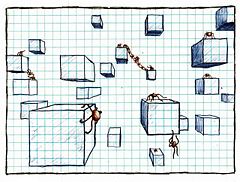Collective phenomena in economy and society: Difference between revisions
Jump to navigation
Jump to search
mNo edit summary |
(References) |
||
| Line 1: | Line 1: | ||
<!-- REALLY BIG QUOTE --> | <!-- REALLY BIG QUOTE --> | ||
<big><big><big><big><big>“</big></big></big></big></big> | <big><big><big><big><big>“</big></big></big></big></big> | ||
| Line 28: | Line 26: | ||
<!-- END OF INFOBOX --> | <!-- END OF INFOBOX --> | ||
Also known as mass action, collective behavior, and artificial chemistry | |||
==Physics Examples== | ==Physics Examples== | ||
| Line 48: | Line 47: | ||
==References== | ==References== | ||
http://www.santafe.edu/research/topics-dynamics-human-behavior-institutions.php | |||
# http://www.santafe.edu/research/topics-dynamics-human-behavior-institutions.php | |||
#''[[Soft Condensed Matter]]'', by Richard A. L. Jones (Oxford University Press, 2007). | |||
#''[[Solid State Physics]]'', by J. R. Hook and H. E. Hall (Wiley, 2007). | |||
# http://www.tcm.phy.cam.ac.uk/~bds10/phase.html | |||
Revision as of 22:52, 21 April 2009
“ Ah, the reason we all majored in physics in the first place... ”
| ||||||||||
Also known as mass action, collective behavior, and artificial chemistry
Physics Examples
- Solitons
- Perturbation theory in quantum mechanics
- Ising Model
- The quantization of magnetic flux in a superconductor
- quantum Hall effect are both collective phenomena associated with thermodynamically large numbers of particles.
Economy
the formation of nations, languages and religions show similarities to condensation of vapor into liquid droplets
Society
Society shows sometimes abrupt changes - revolutions - which are related to phase transitions: both are sudden and dramatic changes of behavior.
Other Examples
Animal Magnetism, like Herding
References
- http://www.santafe.edu/research/topics-dynamics-human-behavior-institutions.php
- Soft Condensed Matter, by Richard A. L. Jones (Oxford University Press, 2007).
- Solid State Physics, by J. R. Hook and H. E. Hall (Wiley, 2007).
- http://www.tcm.phy.cam.ac.uk/~bds10/phase.html

